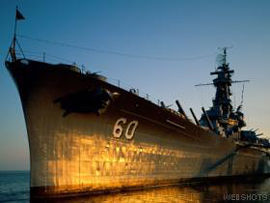How Boats Float
 How does a boat or ship carrying heavy cargo float while that same cargo would sink to the bottom of the ocean if dumped overboard?
How does a boat or ship carrying heavy cargo float while that same cargo would sink to the bottom of the ocean if dumped overboard?
The answer is the boat is pushing down on the water and the water is pushing up. The water pushes up harder than the boat pushes down and so the boat floats.
How Does this Work?
A boat hull is lighter than the total amount of water that the boat’s hull pushes away, or displaces.
Imagine the boat making a hole in the water. So long as the boat weighs less than the weight of the water it would take to fill that hole, it can float.
So, a boat floats when it has displaced just enough water to equal its own original weight – a principle called buoyancy.
Even though a ship is very big and very, very heavy, it is not as heavy as the water it pushes away. That is why a big ship made of steel and full of cargo can float.

Fact
 Archimedes invented the principle of buoyancy which states that an object fully or partly immersed in a liquid is buoyed upward by a force equal to the weight of the liquid moved by that object. From this principle he deduced that a floating object displaces an amount of liquid equal to its own weight.
Archimedes invented the principle of buoyancy which states that an object fully or partly immersed in a liquid is buoyed upward by a force equal to the weight of the liquid moved by that object. From this principle he deduced that a floating object displaces an amount of liquid equal to its own weight.
Credits
Image: Boats by Andrey Voronov
 How does a boat or ship carrying heavy cargo float while that same cargo would sink to the bottom of the ocean if dumped overboard?
How does a boat or ship carrying heavy cargo float while that same cargo would sink to the bottom of the ocean if dumped overboard?

 Archimedes invented the principle of buoyancy which states that an object fully or partly immersed in a liquid is buoyed upward by a force equal to the weight of the liquid moved by that object. From this principle he deduced that a floating object displaces an amount of liquid equal to its own weight.
Archimedes invented the principle of buoyancy which states that an object fully or partly immersed in a liquid is buoyed upward by a force equal to the weight of the liquid moved by that object. From this principle he deduced that a floating object displaces an amount of liquid equal to its own weight.